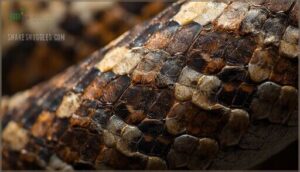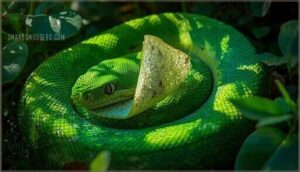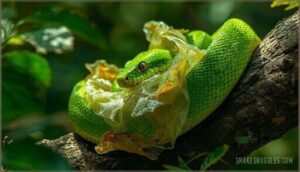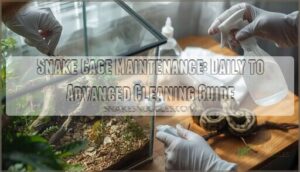This site is supported by our readers. We may earn a commission, at no cost to you, if you purchase through links.
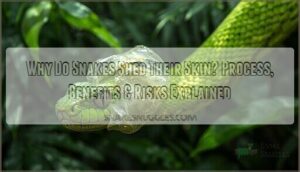 A snake’s skin doesn’t grow with its body—it’s more like wearing a suit that’s permanently your size. As the snake expands, that inflexible outer layer becomes a prison rather than protection, forcing the animal to break free entirely.
A snake’s skin doesn’t grow with its body—it’s more like wearing a suit that’s permanently your size. As the snake expands, that inflexible outer layer becomes a prison rather than protection, forcing the animal to break free entirely.
This shedding process, called ecdysis, isn’t just about making room for a larger frame. It’s a biological reset button that strips away parasites, fungal infections, and damaged tissue in one clean sweep.
Young snakes might shed their skin every few weeks during rapid growth spurts, while adults settle into a slower rhythm. The process demands significant energy and leaves snakes temporarily vulnerable, yet they’ve repeated this ritual for millions of years because the benefits far outweigh the risks.
Table Of Contents
Key Takeaways
- Snakes shed their skin, a process called ecdysis, because their outer layer can’t stretch, making shedding vital for growth and health.
- Shedding acts as a built-in defense, removing parasites, bacteria, and damaged tissue to give the snake a fresh start.
- The process temporarily makes snakes more vulnerable by impairing vision and reducing mobility, so they often hide until it’s done.
- Shed skins are valuable for conservation: scientists use them to identify species, monitor health, and track populations without disturbing wild snakes.
Why Do Snakes Shed Their Skin?
Snakes shed their skin for several interconnected reasons, each playing an important role in their survival and health. The primary driver is growth, but shedding also functions as a defense mechanism against parasites and helps maintain the integrity of their protective outer layer.
Understanding these factors reveals why this energy-intensive process remains essential throughout a snake’s life.
Growth and Expansion Needs
As snakes grow, their rigid keratinized skin can’t stretch to match body growth, making shedding essential for physical expansion. This skin rigidity creates mechanical stress when the body outgrows its outer layer, triggering the snake shedding process.
Metabolic influences like food availability and temperature affect how often this happens—juveniles shed every few weeks due to rapid snake growth, while adults shed three to four times yearly.
Layer formation beneath the existing skin gets ready for this shift, ensuring survival implications remain positive as snakes maintain appropriate protective coverings for their expanding bodies. This process is known as ecdysis, which is necessary for growth and skin health.
Removal of Parasites and Disease
Beyond supporting growth, ecdysis provides critical immunological defense by removing ectoparasites like mites and ticks from the outer epidermal layer. When snakes face fungal infections such as Ophidiomyces ophiodiicola, shedding eliminates up to 85% of these pathogens residing in the cornified skin layers.
Infected individuals often shed twice as frequently as healthy snakes, demonstrating how disease prevention drives this adaptive response. This process is also essential for skin renewal and overall health.
The process also promotes skin healing by removing necrotic tissue and reducing microbial loads, fundamentally giving your snake a fresh start for prime health.
Maintaining Skin Health
Epidermis renewal through shedding directly bolsters barrier function, reducing water permeability by up to 40% post-ecdysis to prevent dehydration in arid habitat demands.
This process facilitates wound healing by removing damaged keratin and promoting cellular regeneration across snake skin layers. Fresh skin also resists abrasion better, maintaining snake health during locomotion.
Ultimately, regular ecdysis keeps your snake’s skin structure optimized for protection, hydration, and environmental adaptation throughout its life.
How is Snake Skin Structured?
Before you can understand why snakes shed, you need to know what you’re looking at. Snake skin isn’t just one simple layer—it’s a complex structure with distinct parts that work together.
Let’s break down the key components that make this impressive covering function so effectively.
Epidermis and Dermis Layers
Think of your skin as a two-story house: snakes rely on a similar setup. The epidermis forms the tough outer armor, built from four distinct layers—oberhautchen, b-layer, mesos layer, and a-layer—with keratin composition varying throughout. Below sits the dermis, a thinner foundation packed with collagen, sensory fibers, and pigment cells that create those striking patterns.
Epidermal thickness differs across species, while layer interactions between lipid-rich regions and protein zones control water loss and flexibility, keeping snakes protected and mobile.
Function of Scales and Keratin
Keratin scales act like overlapping armor plates, minimizing water loss while enabling smooth locomotion across diverse terrains. These beta-keratin proteins, rich in cysteine and glycine, create remarkable toughness you won’t find in most animals.
Scale microstructure varies dramatically—ventral scales often feature hydrodynamic adaptations in aquatic species, while sensory scales detect environmental changes.
The keratin-rich b-layer acts as the primary pigmentation repository, determining those vivid patterns that make each snake unique through millions of years of keratin evolution.
Flexibility and Protection Roles
Snake skin strikes a delicate balance between armor and agility. The keratin gradient—ranging from rigid β-keratin outer layers to flexible α-keratin beneath—provides abrasion resistance without sacrificing locomotion adaptation.
Ventral scales exhibit microstructure friction properties that reduce drag by up to 23%.
Species variations reveal striking adaptations: desert snakes feature thinner, granular layers for sand navigation, whereas arboreal species develop thickened scales for gripping bark.
What Happens During The Shedding Process?
Shedding, or ecdysis, unfolds through a series of distinct physiological changes that prepare the snake’s body for the transformation.
You’ll notice behavioral shifts and visible signs as the old skin separates from the new layer beneath.
Let’s break down what actually happens during each stage of this extraordinary process.
Ecdysis Explained
Ecdysis is the formal term for how snakes replace their entire outer skin layer. During this process, cellular proliferation creates a fresh, three-tiered epidermis beneath the old one, while specialized fluids loosen the bond between layers.
The snake initiates the shed by rubbing its head against rough surfaces, creating a tear that allows the old skin to peel away in one continuous piece, turned inside-out like removing a sock.
Physiological and Behavioral Changes
Before shedding begins, your snake’s body undergoes hormonal shifts—thyroid hormones like thyroxine trigger new skin production beneath the old layer.
These physiological changes in snakes include reduced appetite, increased hiding, and a drop in activity by up to 60%. You’ll notice sensory changes too: clouded eyes impair vision for several days, forcing reliance on touch and scent.
Metabolic adjustments ramp up energy use for keratin synthesis, making ecdysis surprisingly costly—about 3–11% of annual energy expenditure.
Stages of Shedding Skin
You’ll recognize the shedding process through four distinct ecdysis stages. The pre-shedding phase lasts 7–15 days, marked by dull coloration and milky eyes as fluid builds between skin layers.
Next, the blue phase (4–7 days) brings opaque, cloudy eyes and reduced activity.
During the clearing stage (4–7 days), your snake’s eyes clear and normal color returns, signaling imminent skin renewal.
How Often Do Snakes Shed Skin?
Shedding frequency isn’t one-size-fits-all, and several key factors determine how often a snake will slip out of its old skin. Age plays the biggest role, but species differences and major life events also influence the timing.
Let’s look at what affects how often you’ll find a snake going through ecdysis.
Age and Growth Rate Factors
You might wonder how a snake’s developmental stages drive shedding frequency—the answer lies in growth patterns and metabolic demands. Juvenile snakes shed every 4–6 weeks as their bodies rapidly elongate, while adults may shed just 2–4 times annually once skeletal maturity sets in. Age factors directly influence this process:
- Growth hormones and thyroid activity in young snakes accelerate ecdysis up to 8–10 times per year
- Metabolic rate elevation during shedding requires about 3% of a snake’s annual energy budget
- Neonates complete their first shed around 10 days post-birth, marking the end of embryonic development
- Adult snakes exhibit 20–30% slower epidermal regeneration compared to juveniles due to reduced cellular turnover
Influence of Species and Environment
Your snake’s species and environment work together to shape its shedding rhythm. Tropical pythons in humid habitats may shed 4–6 times yearly, while desert rattlesnakes in arid climates average just 2–3 cycles due to slower metabolic rates.
Temperature gradients between 25–30°C enhance ecdysis, and humidity above 60% prevents incomplete sheds—showing how climate effects and habitat influence directly alter shedding frequency across different snake species.
Life Events Impacting Shedding Frequency
Beyond climate patterns, major life events and hormonal changes act like circuit breakers for your snake’s shedding frequency. Reproductive cycles can slash shedding by 50% in gravid females as energy shifts to embryo development, while breeding males may shed just before mating when testosterone peaks.
- Hibernation interrupts ecdysis, resuming 2–4 weeks after emergence from brumation
- Nutritional factors drive timing—well-fed juveniles shed 8–10 times yearly versus 3–4 in adults
- Post-oviposition shedding occurs within 2–4 weeks after egg-laying to remove pathogens
- Environmental stress like drought delays shed cycles and causes epidermal thinning
Growth patterns and snake health and shedding remain closely linked through these critical moments.
What Are The Benefits and Risks of Shedding?
Shedding offers snakes clear advantages, but the process isn’t without its challenges. While ecdysis removes parasites and refreshes the skin’s protective barrier, it also leaves snakes temporarily exposed to dangers they’d normally avoid.
Understanding both sides helps you appreciate why this natural cycle matters so much to a snake’s survival.
Health Improvements and Parasite Removal
One of ecdysis benefits you’ll appreciate most is how it addresses parasite control and aids snake health and shedding cycles. When your snake sheds, the removal of parasites like mites occurs naturally, eliminating external pests that cause irritation and disease.
This skin renewal process also strips away harmful bacteria and fungi, giving your snake an immune boost while promoting health maintenance through a fresh, clean surface.
Temporary Vulnerability to Predators
While shedding offers clear health advantages, you should understand that this process temporarily increases snake vulnerability to predators. During the pre-shed “blue phase,” which lasts four to seven days, impaired vision and sluggish movement compromise defensive strategies and predator avoidance.
Vulnerability periods create heightened risk through:
- Reduced visual acuity: Clouded eye caps limit motion detection, weakening snake camouflage effectiveness
- Decreased mobility: Energy conservation makes snakes slower to flee during predator-prey encounters
- Extended shelter time: Reduced foraging for two to five days restricts escape options
- Predator recognition: Raptors and mammals exploit the “blue-eyed” condition to target vulnerable individuals
- Metabolic costs: Three to eleven percent annual energy loss delays recovery of normal vigilance
This snake vulnerability to predators explains why individuals seek isolated burrows and relocate immediately after shedding, minimizing exposure to threats.
Vision Impairment During Shedding
How does spectacle opacity affect your snake’s ability to navigate its environment? Vision impairment during shedding occurs when fluid accumulates beneath the eye caps, creating a milky appearance called ocular turbidity. This shedding blindness reduces visual acuity for seven to fifteen days, forcing you to recognize distinct stages of snake vision impairment before, during, and after ecdysis.
| Shedding Phase | Spectacle Appearance | Visual Capability |
|---|---|---|
| Pre-Blue (Normal) | Clear, transparent | Full visual acuity with constricted blood vessels |
| Blue Phase (Opaque) | Cloudy, milky-gray | Near-blindness; light scatters through fluid layer |
| Clear Phase | Transparent again | Vision restored before skin detaches |
| Post-Shed (Normal) | Clear, new spectacle | Baseline visual function returns completely |
| Retained Eye Cap | Dull, clouded | Impaired navigation; requires humidity correction |
Retained spectacles, or eye caps that fail to detach, progressively worsen vision across multiple sheds if humidity remains inadequate.
How Does Shedding Help Snake Conservation?
Snake shedding isn’t just a personal health matter for these reptiles—it’s also a goldmine for conservation efforts. When snakes leave behind their papery skins, they’re basically dropping biodiversity breadcrumbs that researchers can follow.
Here’s how those discarded layers help scientists protect snake populations.
Species Identification From Shed Skins
When you find a snake skin lying in the underbrush, you’re holding a biological record that can reveal the species that left it behind. Scientists use morphological analysis and microscopic identification to examine shed skin patterns, counting midbody dorsal scale rows and observing scale keeling to distinguish between species.
Genetic fingerprinting from DNA extracted from snake skin further strengthens snake species identification, supporting conservation applications and tracking species biodiversity across habitats.
Monitoring Population and Health
By collecting shed skins in the field, you can track genetic diversity and detect population trends without disturbing live snakes. DNA extracted from these samples reveals snake disease prevalence and assesses health across different snake habitats, helping conservationists identify population decline and habitat suitability.
However, sampling limitations exist—humidity degrades DNA quality, and environmental contamination can compromise disease detection efforts, requiring timely collection for reliable conservation data.
Research and Biodiversity Insights
You can think of shed skins as nature’s genetic library cards—each one unlocks insights into snake diversity, evolutionary history, and ecosystem health. Genetic applications enable whole-genome sequencing that reveals species-specific adaptations in scale development and pigmentation genes.
Shed snake skin serves as a genetic library card, revealing unique clues about species diversity and evolutionary history in a single piece
Biodiversity monitoring through citizen-science shed collection tracks elusive populations across fragmented habitats, while microbial interactions on snake skin surfaces help researchers understand disease susceptibility.
Disease surveillance using shed-based pathogen screening detects emerging threats like fungal infections, and evolutionary insights from comparative genomics reveal how snakes adapted through limb loss and sensory specialization over 150 million years.
Frequently Asked Questions (FAQs)
Can snakes control when they shed their skin?
No, snakes can’t voluntarily trigger shedding—hormonal signals and environmental factors dictate timing.
Behavioral signs like dullness or hiding emerge as internal cues prompt ecdysis, but the shedding process itself remains involuntary, driven by growth needs and stress responses rather than conscious control.
Do all snake species shed the same way?
While the shedding process follows the same basic pattern across species, variations exist in frequency, duration, and environmental sensitivity.
Juvenile ball pythons shed every 4-6 weeks, whereas adult Timber Rattlesnakes may only shed 1-2 times annually, demonstrating how age differences and species-specific traits influence the shedding process.
What should you do if you find shed snake skin?
Don’t worry—handling shed snake skin is safe with basic precautions. You can document the slough with photos, noting snake markings and skin condition for species identification.
Preserve it by air-drying for research, or report your find to wildlife agencies. This data reporting aids conservation and ecological impact studies, helping monitor biodiversity.
Is shedding painful or uncomfortable for snakes?
Under normal conditions, shedding isn’t painful for snakes. The natural process of ecdysis involves a lubricating layer that allows smooth skin removal.
However, dysecdysis—abnormal sloughing caused by low humidity, dehydration, or skin infections—can create real discomfort and secondary health issues.
How can you tell if a pet snake is about to shed?
Think of your snake as a weather vane—when visual cues, like dull skin or ocular changes such as cloudy eyes with a milky blue color appear, paired with behavioral shifts and seeking behaviors, these are reliable physical signs that shedding is near.
Conclusion
Imagine a snake’s yearly planner—full of appointments with vulnerability, growth, and fresh starts. Shedding isn’t simply cosmetic; it’s this animal’s essential strategy for managing health, development, and survival all at once.
Next time you wonder why snakes shed skin, think of it as more than escape from a too-tight suit. Each shed holds clues for science and conservation, reflecting millions of years of adaptation in motion, right beneath your feet, quietly doing nature’s work.
- https://www.iowadnr.gov/news-release/2015-08-25/why-do-snakes-shed-their-skin
- https://www.britannica.com/science/Why-Do-Snakes-Shed-Their-Skin
- https://www.reconnectwithnature.org/news-events/the-buzz/nature-curiosity-why-do-snakes-shed-their-skin/
- https://www.livescience.com/animals/snakes/why-do-snakes-shed-their-skin
- https://a-z-animals.com/animals/snake/why-do-snakes-shed/

